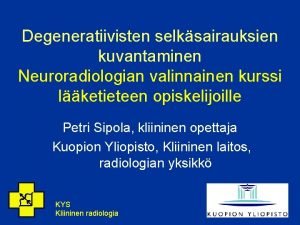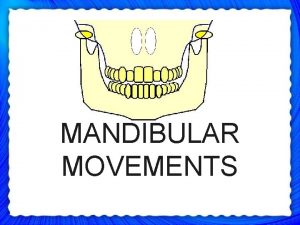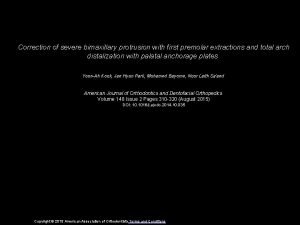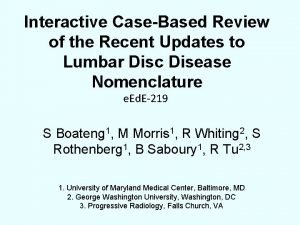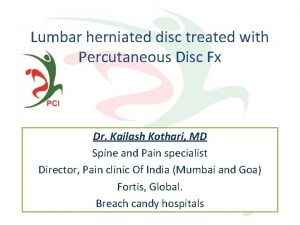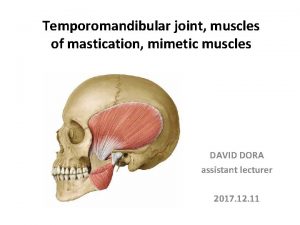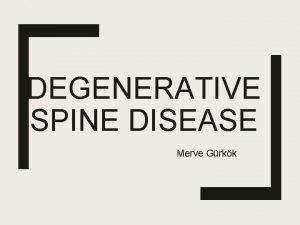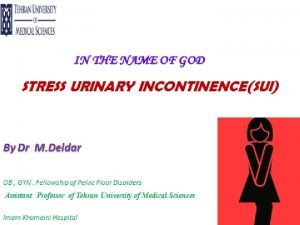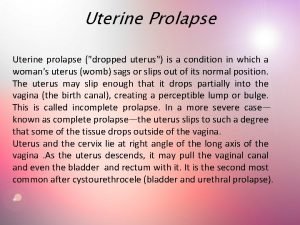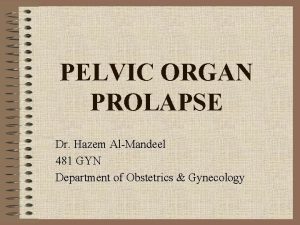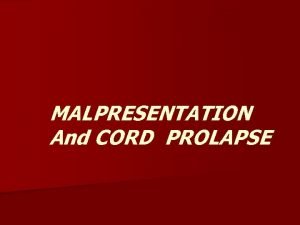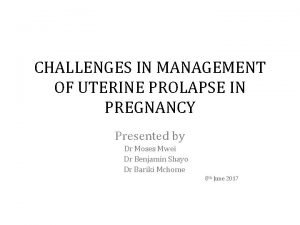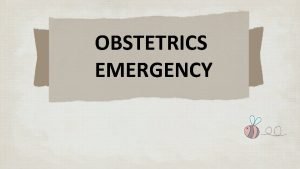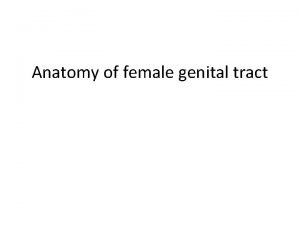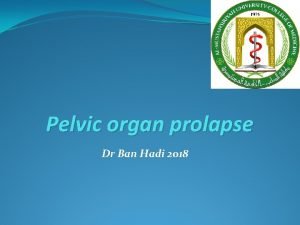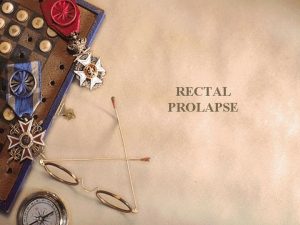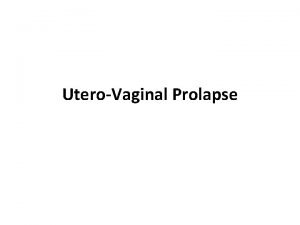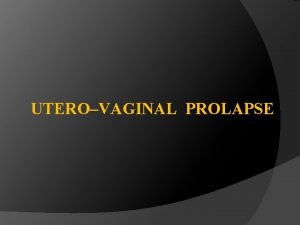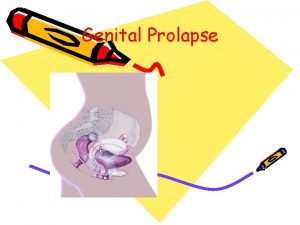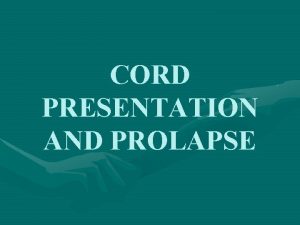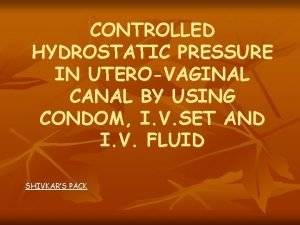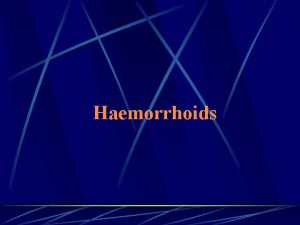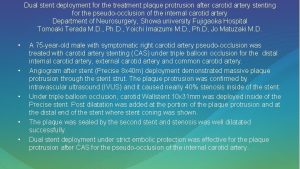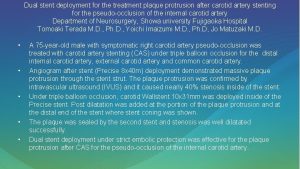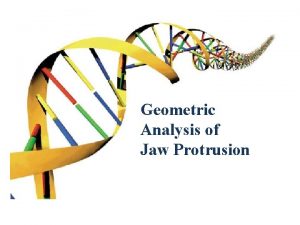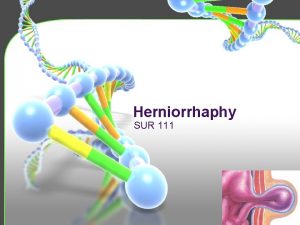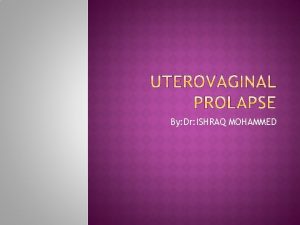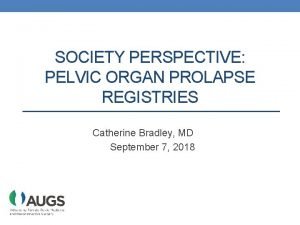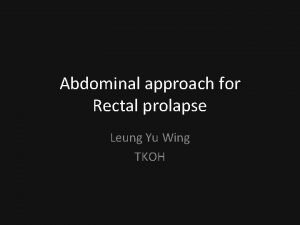UTEROVAGINAL PROLAPSE A prolapse is a protrusion of













































- Slides: 45

UTEROVAGINAL PROLAPSE

• A prolapse is a protrusion of an organ or structure beyond its normal anatomical confines • Prolapses are classified according to their location and the organs contained within them.

Introduction • Up to half of the normal female population will develop uterovaginal prolapse during their lifetime. • Twenty percent of these women will be symptomatic and need treatment. • woman up to the age of 80 years has an 11% risk of needing surgery for pelvic floor weakness. Furthermore, • if she has an operation, she has a 29% risk of requiring further surgery.

Anatomic Supports • Muscular : Levator Ani (Pelvic Floor Muscle) • Ligaments : Uterosacral-Cardinal Complex • Fascial : Endopelvic (Pubocervical & Rectovaginal)



De. Lancey connective tissue support • Level 1 (apical vaginal) – uterosacral & cardinal ligaments---damage result in uterine/vaginal vault prolapse. • Level 2 (mid vaginal)– endopelvic fascia and its lateral insertion into white line--- damage result in cystocele and rectocele. • Level 3 (distal vaginal)– incorporates endopelvic fascia anteriorly and perineal body posteriorly damage result in deficient perineal body and urethrocele.

Pathophysiology of pelvic floor dysfunction • Muscle – gradual denervation with age--result in a gradual weakening of the muscle over time. – Pelvic floor muscle denervation is increased by vaginal delivery, particularly if the active second stage of labour is prolonged

• Fascia is composed of a number of components including collagen, elastin and smooth muscle embedded in a connective tissue matrix. – Congenital – Age – Childbirth injury – Endocrine

Predisposing Factors Hereditary (genetic) predisposition Race: White > Black > Asian Pregnancy and Vaginal Childbirth Age and Menopause Raised intra-abdominal pressure (e. g. : obesity, cough, constipation, lifting, etc) • Iatrogenic: surgical procedure • • •

Classification • Anterior vaginal wall prolapse – Urethrocele: urethral descent – Cystocele: bladder descent – Cystourethrocele: descent of bladder and urethra • Posterior vaginal wall prolapse – Rectocele: rectal descent – Enterocele: small bowel descent • Apical vaginal prolapse – Uterovaginal: uterine descent with inversion of vaginal apex – Vault: post-hysterectomy inversion of vaginal apex


Anterior Vaginal wall prolapse

Rectocele

Apical prolapse



Symptoms of Prolapse • Pelvic floor disorders become symptomatic through either of two mechanisms: 1. Mechanical difficulties produced by the actual prolapse. 2. Bladder or bowel dysfunction, disrupting either storage or emptying.

Clinical presentation • Before actual prolapse. the patient feels a sensation of weakness in the perineum. particularly towards the end of the day • Later the patient notices a mass which appears on straining. and disappears when she lies down • Urinary symptoms : a) Urgency and frequency by day b) Stress incontinence c) Inability to micturate unless the anterior vaginal wall is pushed upwards by the patient's fingers d) Frequency when cystitis develops

• Rectal symptoms • • not so marked. feels heaviness in the rectum constant desire to defaecate. Piles develop from straining. • Backache • Leucorrhoea • caused by the congestion and associated by chronic cervicitis. • decubitus ulcer • purulent or blood stained discharge • Coital symptoms – fear, discomfort, embarrassment

Examination & investigations • General examination – general medical fitness, including fitness for surgery. – Chronic chest conditions and obesity increase the risk of prolapse. • Abdominal examination -- intra abdominal mass.

• Position – horizontal position, conventionally in the left lateral position with a Sims ’ speculum. – If prolapse is not evident, even with a Valsalva manoeuvre, the patient should be examined in the upright position. – The POPQ examination gives an objective record of the prolapse stage.

• Local examination – with a careful inspection of the vulva and vagina to identify erosions, ulcerations, or other lesions – The extent of prolapse should be systematically assessed – Suspicious lesions should be biopsied

• • • Per speculum examination Per vaginal/ Bimanual examination Cough stress test Evaluation of tone of pelvic muscles Recto vaginal examination

Investigation • Ultrasound -- exclude a pelvic mass, size of the uterus and ovaries • Urodynamic studies – – • • Only justified when urinary symptoms present If obstructive voiding--- good prognosis for surgical repair If atonic bladder—less favourable prognosis Overactive bladder– less likely that surgery will improve symptoms Proctography Magnetic resonance imaging TPUS (transperineal ultrasound) Anorectal studies if bowel dysfunction particularly fecal incontinence

MANAGEMENT OF UTERINE PROLAPSE • Goal of treatment -Alleviate symptoms -Restore anatomical structure -Restore/Preserve sexual function • Choice of treatment depends on -Symptoms severity -Prolapse severity -Fertility desire

Treatment---Conservative • Lifestyle advice – advice on diet and weight loss including avoidance of drinks with caffeine, water intake, fibre content, laxative use and modifi cation of drug regimes, e. g. diuretics. – Avoidance of high – impact exercise and lifting may improve symptoms. • Pelvic floor physiotherapy – earlier stage prolapse may be improved sufficiently to avoid further intervention. • Influence only the voluntary muscles • No action to the fascial supporting system • “Kegel” exercises


Pessary • During pregnancy • Immediately after pregnancy, during lactation • When future childbearing is intended in near future • Refusal to operation by patient • As a therapeutic test • To promote healing in a decubital ulcer • Patient has other comorbidities risk for surgery • Propylene ring pessary • Silicon rubber pessary

Pessary in situ

Complications of pessary • • • Constipation Urinary incontinance B. vaginitis, ulceration of vaginal wall Cervicitis Impaction of pessary Strangulation of prolapsed tissue

Uterine prolapse Uterine preserving surgery • Hysterosacropexy: – open route or a laparoscopic route – Mesh is attached to the isthmus of the cervix and the uterus is suspended by attaching the other part of the mesh to the anterior longitudinal ligament on the sacrum.

• The Manchester repair: – amputating the cervix and using the uterosacral cardinal ligament complex to support the uterus.


• Le Fort colpocleisis: – unfit for major surgery and are not sexually active. – It involves partial closure of the vagina while preserving the uterus.

Procedures involving hysterectomy • Vaginal hysterectomy: • Total abdominal hysterectomy and sacrocolpopexy: • Subtotal abdominal hysterectomy and sacrocervicopexy:

Vaginal vault prolapse • Abdominal sacrocolpopexy – Success rate 74 -100% – Mesh erosion 2 -11% – Should be performed in Young women • Vaginal sacrospinous ligament fixation (right sided or bilateral) – Anatomical cure rate 63 -97% – In frail women

Sacral colpopexy

Uterosacral suspension

Sacrospinous suspension

Augmentation of vaginal repairs • The high reported risk of failure or recurrence following vaginal repair surgery has led to an increased use in recent years of implants to supplement the fascial repair. – Absorbable, non -absorbable materials – synthetic or harvested from animals or humans. • Risks—dyspareunia , Mesh erosion 10% of cases, • macroporous, monofilament polypropylene construction with lower material weight and density than previously employed

Associated decubitus ulcer • To relieve congestion, the prolapse can be reposited in the vagina with the help of tompoons ar pessary and this helps in healing of the ulcer • Hygroscopic agents like acriflavin-glycerine can help reduce the congestion further

Prevention • During labour &puerperium – Avoid premature bearing down – Avoid long second stage – Repairs all tears &incisions accurately in layers – Use delayed absorbable suture – Do not express the uterus when attempting to deliver placenta – Encourage pelvic floor exercise – Avoid puerperal constipation-decreases bearing down

Prevention • At hysterectomy – Vault suspension with uterosacral and cardinal ligaments – Obliteration of deep cul-de –sac by Moschowitz sutures – Sacropexy in high risk situations like collagen disorders – Increase acceptability of estrogen replacement therapy

Thank you
 Skleroosi selässä
Skleroosi selässä Immediate side shift
Immediate side shift Incidence blondeau
Incidence blondeau Bimaxillary protrusion
Bimaxillary protrusion Guia anterior y guia canina
Guia anterior y guia canina Mandibular protrusion test
Mandibular protrusion test Central disc protrusion mri
Central disc protrusion mri Protrusion discale
Protrusion discale Disc-fx
Disc-fx Linea alba hernia
Linea alba hernia Medial pterygoid
Medial pterygoid Spigelian
Spigelian Imaging at lafayette surgical specialty hospital
Imaging at lafayette surgical specialty hospital Spinal cord extends from
Spinal cord extends from Uterine prolapse stages pictures
Uterine prolapse stages pictures Womb dropped
Womb dropped Munchausen by proxy definition
Munchausen by proxy definition Types of uterine prolapse
Types of uterine prolapse Umbilical cord prolapse nursing diagnosis
Umbilical cord prolapse nursing diagnosis Vagina prolapse
Vagina prolapse Cystocele with incomplete uterine prolapse
Cystocele with incomplete uterine prolapse Umbilical cord prolapse
Umbilical cord prolapse Vaginak prolapse
Vaginak prolapse Vaginal vault prolapse
Vaginal vault prolapse Vaginal pessary
Vaginal pessary
